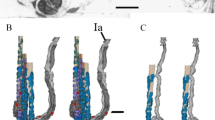Summary
A mechano-electric model of the secondary endings of the mammalian muscle spindle receptors has been developed. The model involves a mechanical system with second order transfer dynamics connected to a zero order mechano-electric transducer with constant gain.
The mechanical system is supposed to describe the viscoelastic properties of the intrafusal muscle fibres, and this part of the model is identical to that used in connection with an earlier proposed model of the primary endings (Rudjord, 1970).
The general transfer properties of the model are derived, together with a description of the particular response components obtained during a linear extension of the mechanical system.
A simple direct electronic analogue was used for studying the effects of the individual parameters and for a preliminary estimate of an adequate set of parameter values.
With appropriate parameter values, a close correspondence could be obtained between the behaviour of the model and the typical response properties of the secondary endings of the muscle spindles.
The order of magnitude of the best parameter fit also appeared to correspond to the values previously found to yield an adequate description of the transfer properties of the primary endings.
It is further shown that for the best fit of the mechanical parameters, the secondary ending model may be approximated by a simple first order system with lead-lag transfer behaviour.
The transfer properties of this simplified model appear to agree with the reported response properties of typical secondary ending receptors except for extreme rates of stretch or very high vibrational frequencies of stretch during which the simplifying approximation evidently does not apply.
Similar content being viewed by others
References
Alnaes, E., Jansen, J. K. S., Rudjord, T.: Fusimotor activity in the spinal cat. Acta physiol. scand. 63, 197–212 (1965).
Boyd, I. A.: The structure and innervation of the nuclear bag muscle fibre system and the nuclear chain muscle fibre system in mammalian muscle spindles. Phil. Trans. B 245, 81–136 (1962).
Brown, M. C., Goodwin, G. M., Matthews, P. B. C.: After-effects of fusimotor stimulation on the response of muscle spindle primary afferent endings. J. Physiol. (Lond.) 205, 677–694 (1969).
Crowe, A.: A mechanical model of the mammalian muscle spindle. J. theoret. Biol. 27, 21–41 (1968).
Edwards, C.: Changes in the discharge from a muscle spindle produced by electrotonus in the sensory nerve. J. Physiol. (Lond.) 127, 636–640 (1955).
Eldred, E., Granit, R., Merton, P. A.: Supraspinal control of the muscle spindles and its significance. J. Physiol. (Lond.) 122, 498–523 (1953).
Eldred, E., Yellin, H., Gadbois, L., Sweeney, S.: Bibliography on muscle receptors; their morphology, pathology, and physiology. Exp. Neurol., Suppl. 3, 1–154 (1967).
Fehr, H. V.: Aktivität der Muskelspindel-Endigungen der Fasergruppen I a und II als Funktion der Muskelelongation. Helv. physiol. pharmacol. Acta 20, 163–172 (1962).
Harvey, R. J., Matthews, P. B. C.: The response of de-efferented muscle spindle endings in the cat's soleus to slow extensions of the muscle. J. Physiol. (Lond.) 157, 370–392 (1961).
Houk, J. C., Cornew, R. W., Stark, L.: A model of adaptation in amphibian spindle receptors. J. theoret. Biol. 12, 196–215 (1966).
Jansen, J. K. S., Matthews, P. B. C.: The central control of the dynamic response of muscle spindle receptors. J. Physiol. (Lond.) 161, 357–378 (1962).
Landon, D. N.: Electron microscopy of muscle spindles. In: B. L. Andrew (ed.), Control and innervation of skeletal muscles. Edinburgh and London: University of St. Andrew, E. & S. Livingstone Ltd. 1966.
Lippold, O. C. J., Nicholls, J. G., Redfearn, J. W. T.: Electrical and mechanical factors in the adaptation of a mammalian muscle spindle. J. Physiol. (Lond.) 153, 209–217 (1960).
Matthews, P. B. C.: The response of de-efferented muscle spindle receptors to stretching at different velocities. J. Physiol. (Lond.) 168, 660–678 (1963).
—: Muscle spindles and their motor control. Physiol. Rev. 44, 219–288 (1964).
—, Stein, R. B.: The sensitivity of muscle spindle afferents to small sinusoidal changes of length. J. Physiol. (Lond.) 200, 723–743 (1969).
Poppele, R. E., Bowman, R. J.: Linear analysis of muscle spindles. In: Carlo A. Terzuolo (ed.), System analysis approach to neurophysiological problems. Brainerd, Minn.: University of Minnesota 1969.
—: Quantitative description of linear behaviour of mammalian muscle spindles. J. Neurophysiol. 33, 59–72 (1970).
Rudjord, T.: Noise suppression in muscle spindle receptors. VIII Int. Conf. on med. biol. Engng. Chicago 1969a.
Rudjord, T.:Muscle spindle model with nonlinear transfer characteristics. III. Biophys. Congr. Int. Union pure and applied Bio-physics. Cambridge, Mass. 1969b.
— A second order mechanical model of muscle spindle primary endings. Kybernetik 6, 205–213 (1970).
Stark, L., Houk, J.: An analytical model of a muscle spindle receptor for simulation of motor coordination. Quat. Progr. Report. 66, p. 384. Res. Lab. Electr. MIT, 1962.
Stein, R. B., Matthews, P. B. C.: Differences in variability of discharge frequency between primary and secondary muscle spindle afferent endings of the cat. Nature (Lond.) 208, 1217–1218 (1965).
Terzuolo, C. A., Purple, R. L., Bayly, E., Handelman, E.: Postsynaptic inhibition — Its actions upon the transducer and encoder systems of neurons. In: Structure and function of inhibitory neural mechanisms. New York: Pergamon 1968.
Toyama, K.: An analysis of impulse discharges from the spindle receptor. Jap. J. Physiol. 16, 113–125 (1966).
Vossius, G.: Das System der Augenbewegung. Z. Biol. 112, 27–57 (1960).
Whitteridge, D.: The effect of stimulation of intrafusal muscle fibres on sensitivity to stretch of extraocular muscle spindles. Quart. J. exp. Physiol. 44, 385–393 (1959).
Author information
Authors and Affiliations
Rights and permissions
About this article
Cite this article
Rudjord, T. A mechanical model of the secondary endings of mammalian muscle spindles. Kybernetik 7, 122–128 (1970). https://doi.org/10.1007/BF00292457
Received:
Issue Date:
DOI: https://doi.org/10.1007/BF00292457




